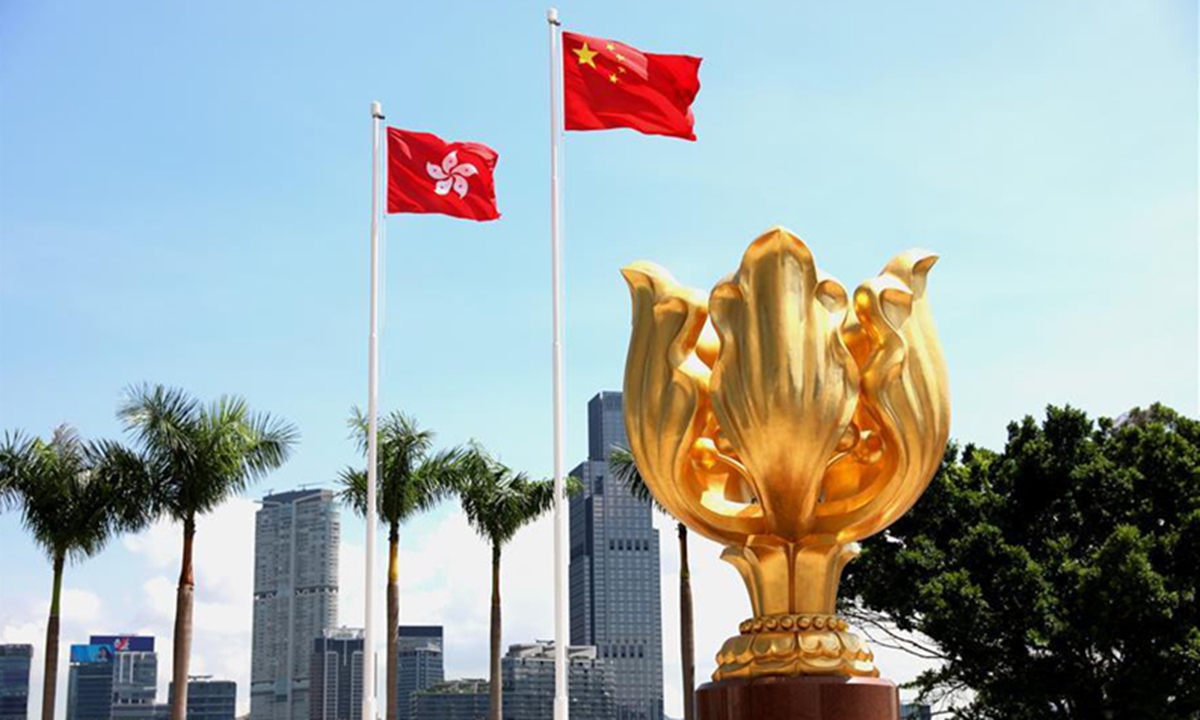Social structure, long-term economic transformation lead to Hong Kong's labor shortage

Hong Kong file photo
On the July 15, the Hong Kong Labor Department announced the launch of the Re-employment Allowance Pilot Scheme, which had immediately began accepting registrations. The initiative aims to encourage middle-aged and older individuals to re-enter the labor market. This move is seen as another response to Hong Kong's current severe labor shortage. However, behind this measure, there may be greater challenges stemming from Hong Kong's social structure and long-term economic transformation.
Why do many of Hong Kong's "silver-haired" individuals continue working after retirement?
Hong Kong currently has no statutory retirement age. Except for civil servants and specific positions like bus drivers, most industries allow individuals who wish to continue working to do so as long as they can secure employment. Therefore, it is not uncommon to see people over 60 or 65 still working. During interviews in Hong Kong, a Global Times reporter often encounter "silver-haired" individuals working on the streets or in shops.
A 2021 census by the Hong Kong Special Administrative Region government showed that there were about 1.45 million people aged 65 or older in Hong Kong, with 210,000 of them in the workforce, nearly three times the number from a decade ago. The labor force participation rate for this age group was 14.6 percent, meaning almost one in seven elderly people continued working. According to data from December 2022 to February 2023, the labor force participation rate for those aged 65 and above was 13.9 percent, and 48. percent for those aged 60 to 64. In Hong Kong, the employed elderly mainly work in real estate, professional, and business services, accounting for about 30 percent of this group.
Hong Kong economist and president of the China Silk Road iValley Research Institute, told the Global Times that the reasons for some elderly in Hong Kong continuing to work stems from concerns about insufficient pensions or retirement savings, and various social, economic, and institutional factors. For instance, Hong Kong has a high level of health and education, a more accepting workplace culture for older people, and a reduced demand for manual labor, leading many middle-aged and older individuals to choose to keep working.
"One of the most important factors is that the HKSAR government has consistently promoted elderly employment," Liang said. Although Hong Kong has no statutory retirement age, to address the challenges posed by an aging population, the HKSAR government, as the largest local employer, raised the retirement age for newly hired civil servants from 60 to 65 for clerical grades and from 55/57 to 60 for disciplined services grades starting in June 2015, he said.
Following the lead of the HKSAR government, many public institutions and companies in the private sector have adopted similar practices, providing employment opportunities for healthy elderly individuals and helping to ease recruitment difficulties in the industry, Liang said.
There are "two changes" behind Hong Kong's labor shortage. The HKSAR government's encouragement for middle-aged and older individuals to continue working is in response to a significant issue that has drawn considerable attention in recent years— the reduction in the labor force and the severe labor shortage.
According to a previous report by the Sing Tao Daily, by the end of 2023, Hong Kong's labor force was 3.776 million strong, a decrease of 94,000 from the previous year, with an annual decline rate of 2.4 percent. The report indicated that many industries in Hong Kong are facing severe labor shortages, particularly in construction, catering, and medical services.
Sing Tao Daily reported that in 2023, the construction industry faced a shortage of 10,000 to 15,000 skilled and semi-skilled workers, with this number expected to reach 35,000 to 40,000 by 2027. The industry also suffers from significant aging issues, with the average age of Hong Kong's 600,000 registered construction workers now at 47, and young people are notably reluctant to join the sector.
The situation in the catering industry is similar. Tommy Cheung Yu-yan, a non-official member of the Executive Council and a Legislative Council member representing the catering industry, told the Global Times that the labor shortage in Hong Kong's catering industry is severe, with a manpower gap of about 20 percent to 30 percent.
"On one hand, this is due to the rapid expansion of Hong Kong's catering industry over the past 15 years. On the other hand, the COVID-19 pandemic severely impacted the industry, causing many employees to either lose their jobs or work only part-time, resulting in unstable income and high employee turnover," Cheung said.
The often-criticized service level in Hong Kong's catering industry is actually related to the severe labor shortage in the industry. "If I need ten waiters but can only hire six, these six people have to handle the workload of ten, which naturally results in significant work pressure. Sometimes the decline in service quality is not because they want to provide poor service but because of the insufficient manpower," explained Cheung.
Public data shows that the aging issue in the catering industry is also critical. According to data from the Census and Statistics Department of the HKSAR government, in the first quarter of 2024, the number of employed persons aged 40 and above in the "retail, accommodation, and food services" industry far exceeded other age groups, reaching 326,700.
The number of those aged 25 to 39 was 156,200, while those aged 15 to 24 numbered only 40,500. Earlier, Wong Ka-wo, president of the Hong Kong Federation of Restaurants & Related Trades, was quoted as saying in media reports that there are currently 18,000 restaurants in Hong Kong, with the average age of employees being 45.
Why is Hong Kong facing this labor shortage? According to Liang, this is mainly due to two "changes."
First one is in population structure. Hong Kong is currently experiencing the aging of it population, with the retired population increasing annually, and the number of young people entering the labor market is insufficient to fill this gap.
Also, Hong Kong's birth rate has been at a low level for a long time, leading to a reduction in the number of young workers. In recent years, some Hong Kong residents, especially young professionals, have chosen to move to other countries or regions, further exacerbating the local labor shortage.
"Second is the change in economic structure. According to the Guangdong-Hong Kong-Macao Greater Bay Area plan," Liang said.
Hong Kong aims to become an international innovation and technology hub. In recent years, Hong Kong has been transitioning from traditional manufacturing and service industries to high-tech and financial industries. These new fields require a large number of highly skilled talents, but local training and education have not kept pace with changing demands.
Also, the salaries and working conditions in some Hong Kong industries, especially the innovation and technology sector, have not been attractive enough to draw sufficient foreign job seekers, Liang said. As a result, in addition to the manpower shortage in some traditional industries, there is also a significant shortage of high-skilled IT professionals, STEM teachers, and other high-end labor.
In order to tackle the labor shortage, Cheung told the Global Times that he and his party will raise the industry's labor shortage during their meeting with the Chief Executive and suggest bringing in more foreign workers to Hong Kong. He specifically mentioned that the proximity of the Greater Bay Area and Hong Kong's relatively higher wage levels might attract more mainland workers to Hong Kong, alleviating the labor shortage.
In terms of attracting high-end labor, Liang believes that apart from offering high salaries and favorable policies, Hong Kong should offer a good "soft environment" and a large enough stage, for example, more development space and business opportunities.
To attract talent, Hong Kong needs new thinking, focusing on attracting talent through business opportunities and a comfortable living environment, not just through favorable policies. Also, Hong Kong should not only focus on attracting top-tier talent but also pay more attention to "mid-level talent" with business capabilities and experience to build the most efficient and effective teams.
According to public information, in 2023, the Hong Kong Immigration Department received over 220,000 applications for various talent immigration schemes, with about 135,000 approved and approximately 90,000 approved talents having already arrived in Hong Kong.
For example, under the "Quality Migrant Admission Scheme," the HKSAR government increased the types of professionals it seeks to attract from January 1, 2023, and announced the removal of the annual quota of 1,000 for two years.
In addition to high-end talent, Hong Kong also implemented special schemes for importing caregivers for elderly homes and workers for the construction and transportation industries last year, based on the severity of labor shortages.
However, the HKSAR government's strong push to bring in external labor has also raised concerns among local residents A local resident of Hong Kong surnamed Lee told the Global Times that he is skeptical about whether foreign labor is necessary.
He believes that introducing outside labor across various industries will inevitably impact local employment, and employers might suppress local wages due to the availability of outside labor. He noted that some local incomes have already been decreasing.
In response, Liang suggested that while attracting talent and outside labor, it is essential to listen to the opinions and suggestions of local residents, considering their interests to prevent them from feeling that their benefits are being undermined by outsiders.
At the same time, the HKSAR government should consider strengthening policy explanations and publicity regarding talent and labor attraction to ensure that citizens correctly understand the policies and reduce suspicion and dissatisfaction.

